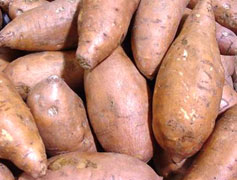


Home
Flowers &
Indoor Plants
Fruits & Nuts
Ornamentals
Vegetables
Special Topics
Resources
Glossary

|
Sweet Potato Ipomoea batatus (i-po-mee-ah bah-tah-tus) 

 Click on thumbnails for larger image.> |
 |
What about it? Sweet potatoes are members of the morning glory family. They are native plants of Central and South America. Sweet potatoes are also referred to as yams, although a true yam is a starchy tuber of African origin. What is it used for? The storage root of the sweet potato is the edible portion. These roots can range from a white to an orange and even to a purplish color. Where does it grow? How do we grow it? Sweet potatoes are often considered to be a long-season, space-consuming crop but these impressions are slowly changing. Some of the benefits of the sweet potato are its heat and drought tolerance, its ease of growing, its resistance to pests, and its hearty flavor. Sweet potatoes need 4 frost-free months of growing time and plenty of warm weather. Set slips or sprouts 12-18 inches apart along ridges of tilled soil. Cover the first leaves with soil. You can expect a pound of sweet potatoes for a foot of row, if conditions are somewhat normal. Sweet potatoes will need lots of water during the dry periods, but water less near harvest time if you plan to store the root. The biggest yields come through using black plastic mulch and raised beds. Sweet potato vines should be cut before harvesting. What are its primary problems?Rodents tend to be the most serious problem for sweet potatoes. However, flea beetles, sweet potato weevils, and wireworms can become pests. Sweet potato scurf is a disease that can be a problem in heavy, wet soils. How do we harvest and store it? Most sweet potatoes can be harvested by late September or mid-October, but definitely before the first frost Dig out the roots carefully because they bruise easily.
© Copyright, Department of Horticulture, Cornell University. |